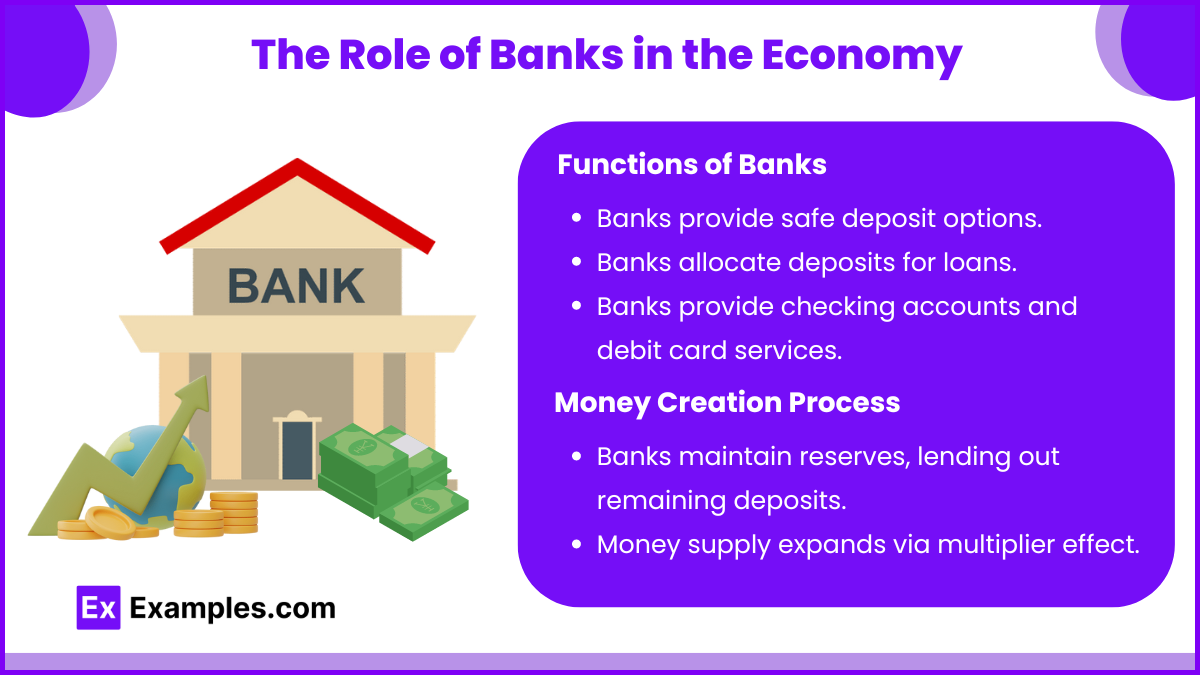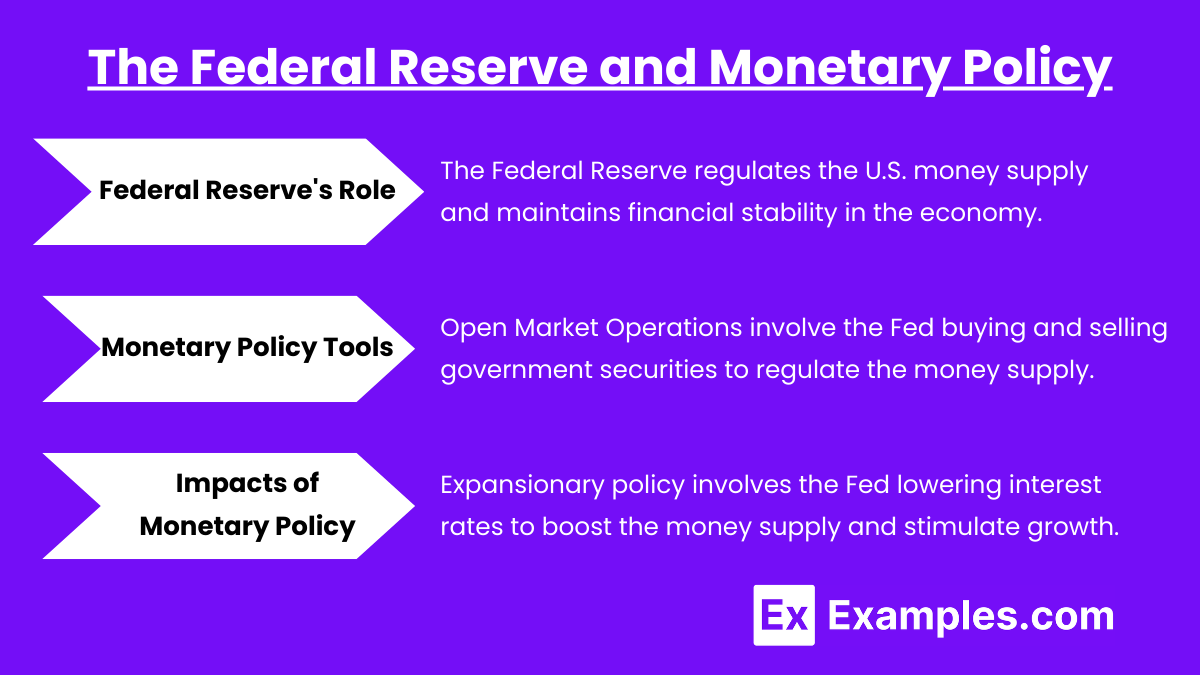Understanding the role of banking in the expansion of the money supply is crucial for the AP Macroeconomics Exam. Banks play a vital role in the economy by accepting deposits, making loans, and facilitating transactions. This process impacts the overall money supply, influencing economic activity, inflation, and interest rates. The mechanics of how banks operate, the concept of fractional reserve banking, and the tools used by the Federal Reserve to control the money supply are essential topics to grasp.
Learning Objectives
In studying “Banking and the Expansion of the Money Supply,” you will explore the fundamental functions of banks, including their role in accepting deposits and making loans. You will understand fractional reserve banking and how it contributes to money creation through the money multiplier effect. Additionally, you will analyze the tools used by the Federal Reserve, such as open market operations and reserve requirements, to manage the money supply and their impact on inflation, interest rates, and overall economic growth.
The Role of Banks in the Economy

- Functions of Banks:
- Accepting Deposits: Banks provide a safe place for individuals and businesses to deposit money. This contributes to the stability of the financial system.
- Making Loans: Banks use a portion of the deposits to provide loans to individuals and businesses, promoting investment and consumption.
- Facilitating Payments: Banks offer payment services, such as checking accounts, debit cards, and electronic transfers, making transactions convenient.
- Money Creation Process:
- Fractional Reserve Banking: Banks are required to keep a fraction of deposits as reserves while they can lend out the rest. For example, if a bank has a reserve requirement of 10%, it can lend out 90% of its deposits.
- Multiplier Effect: The money supply expands through the money multiplier effect. The formula for the money multiplier is: Money Multiplier=Reserve Ratio1 For example, with a reserve ratio of 10% (0.10), the money multiplier would be 10. If a bank receives a deposit of $1,000, it can ultimately create $10,000 in money supply through lending.
The Federal Reserve and Monetary Policy

- Federal Reserve’s Role:
- The Federal Reserve (the Fed) is the central bank of the United States responsible for regulating the money supply and ensuring financial stability.
- It employs various tools to influence the banking system and manage the economy.
- Monetary Policy Tools:
- Open Market Operations: The buying and selling of government securities by the Fed to control the money supply. Buying securities increases the money supply, while selling them decreases it.
- Discount Rate: The interest rate at which commercial banks can borrow from the Fed. Lowering the discount rate encourages banks to borrow more, increasing the money supply.
- Reserve Requirements: The percentage of deposits banks must hold as reserves. Lowering reserve requirements allows banks to lend more, increasing the money supply.
- Impacts of Monetary Policy:
- Expansionary Policy: When the Fed aims to increase the money supply to stimulate economic growth, it lowers interest rates and encourages borrowing and spending.
- Contractionary Policy: To combat inflation, the Fed may reduce the money supply by raising interest rates, which discourages borrowing and spending.
Implications for the Economy

- Inflation and Deflation:
- An increase in the money supply can lead to inflation if it outpaces economic growth. Prices rise as more money chases the same amount of goods.
- Conversely, a decrease in the money supply can lead to deflation, where prices fall, potentially leading to decreased economic activity.
- Interest Rates:
- The money supply directly influences interest rates. An increase in the money supply typically lowers interest rates, making loans cheaper.
- Conversely, a decrease in the money supply raises interest rates, making borrowing more expensive and potentially slowing economic growth.
- Economic Growth:
- A well-managed money supply can support sustainable economic growth, but mismanagement can lead to boom-bust cycles.
Examples
Example 1: Fractional Reserve Banking
In a typical banking system, banks only hold a fraction of their deposits as reserves. For instance, if a bank receives $10,000 in deposits and has a reserve requirement of 10%, it must hold $1,000 in reserves but can lend out $9,000. This process allows the bank to generate interest income while also creating new money in the economy through loans. When borrowers spend this money, it enters circulation, increasing the overall money supply.
Example 2: Open Market Operations
The Federal Reserve conducts open market operations by buying and selling government securities to influence the money supply. For example, if the Fed purchases $1 million in Treasury bonds, it credits the selling banks’ reserves, thereby increasing the banks’ capacity to lend. This action can lead to an expansion of the money supply, as banks lend out a portion of these increased reserves, fueling economic growth and investment.
Example 3: Lowering the Discount Rate
When the Federal Reserve lowers the discount rate, it becomes cheaper for banks to borrow money. For example, if the discount rate is reduced from 3% to 2%, banks may be more inclined to borrow additional funds from the Fed. This increased liquidity enables banks to issue more loans to consumers and businesses, effectively increasing the money supply as more loans circulate through the economy.
Example 4: Changes in Reserve Requirements
If the Federal Reserve decides to lower reserve requirements from 10% to 5%, banks can lend out a greater portion of their deposits. For example, with $100,000 in deposits, a bank with a 10% reserve requirement must hold $10,000 in reserves and can lend out $90,000. If the requirement drops to 5%, the bank now needs only $5,000 in reserves, allowing it to lend $95,000. This increase in lending capacity contributes to an expansion of the money supply, encouraging spending and investment.
Example 5: Impact of Consumer Confidence on Lending
During periods of economic growth, consumer confidence typically rises, leading to increased borrowing and spending. For instance, if consumers feel optimistic about their financial future, they are more likely to take out loans for homes, cars, or businesses. This surge in demand for loans prompts banks to increase lending, thereby expanding the money supply. As more loans are issued and money circulates in the economy, this can stimulate economic growth further.
Multiple Choice questions
Question 1
What is the primary function of the reserve requirement in a fractional reserve banking system?
A) To control inflation by setting interest rates
B) To determine the amount of money that banks can lend out
C) To limit the amount of deposits that can be accepted
D) To regulate the number of bank branches in a region
Correct Answer: B) To determine the amount of money that banks can lend out
Explanation: The reserve requirement is the fraction of deposits that banks must hold as reserves and not lend out. By setting this requirement, the central bank controls how much money banks can create through loans. If the reserve requirement is low, banks can lend more, which expands the money supply. Conversely, a higher reserve requirement restricts lending and contracts the money supply. Thus, the reserve requirement directly influences banks’ lending capacity.
Question 2
If the Federal Reserve decreases the reserve requirement for banks, what is the likely effect on the money supply?
A) The money supply will decrease.
B) The money supply will remain unchanged.
C) The money supply will increase.
D) The money supply will fluctuate unpredictably.
Correct Answer: C) The money supply will increase.
Explanation: When the Federal Reserve decreases the reserve requirement, banks are required to hold a smaller portion of deposits as reserves. This allows banks to lend out a greater percentage of their deposits, thereby increasing the overall money supply through the money multiplier effect. More loans lead to more deposits in the banking system, which further increases the money supply as banks continue to lend.
Question 3
Which of the following actions by the Federal Reserve would directly lead to a decrease in the money supply?
A) Increasing the discount rate
B) Conducting open market purchases of government securities
C) Lowering the reserve requirement
D) Decreasing the federal funds rate
Correct Answer: A) Increasing the discount rate
Explanation: Increasing the discount rate—the interest rate at which banks can borrow from the Federal Reserve—makes borrowing more expensive for banks. As a result, banks are less likely to borrow money from the Fed and may also become more conservative in their lending practices. This leads to a contraction in the money supply, as fewer loans mean fewer deposits are created through the banking system. In contrast, conducting open market purchases, lowering the reserve requirement, or decreasing the federal funds rate would all expand the money supply.


